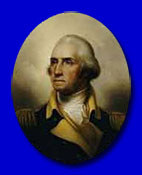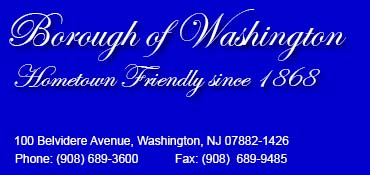Washington Borough History
Washington is a rural borough in northwestern New Jersey in Warren County. As of the United States 2000 Census, the borough population was 6,712. Washington was incorporated as a borough by an Act of the New Jersey Legislature on February 20, 1868, from portions of Washington Township. According to the United States Census Bureau, the borough has a total area of 2.0 square miles (5.1 km2).
The surrounding landscape includes rolling hills as well as Pohatcong Mountain a ridge, approximately 6 mi (10 km) long, in the well known Appalachian Mountains that extends from west Phillipsburg northeast approximately to Washington. Upper Pohatcong Mountain extends northeast of Washington approximately 6 mi (10 km) to the vicinity of Hackettstown. The two ridges are sometimes called "Pohatcong Mountain" collectively.
History:
Washington Borough, named for America’s first President, separated from Washington Township, which completely surrounds it, in 1868. The community grew during the 19th century as a result of the commercial transportation routes that ran through or near the borough. The innovative Morris Canal opened in 1831 and was used through the late 1870’s. It ran along the north end of town until it was eventually drained in 1924. To see a piece of this history there is a “Morris Canal” sign on Belvidere Avenue across from the current site of Warren Lumber Company where the original canal crossed the current Belvidere Avenue as well as another Morris Canal sign along another crossing on the corner of Myrtle Avenue and Rt. 31. Washington was also an important railroad center with multiple railroad stations and even a hotel across from one of the stations. At its peak in 1909 the railroad employed more than 400 men. On October 6, 1966 the last passenger train left the Washington Station. Now intersecting in the center of the borough are two major roadways, which today are Route 31 and Route 57. The borough also served as a hub center for the farmers of the surrounding townships.
The Borough’s oldest existing building has a marker that reads 1756 but it probably dates back to 1732. It was built by Thomas Van Horn. As of 2003 it was still in use as an office by Opdyke Sales and Service Company.
The first school was established in 1811 which was the same year that Colonel William McCullough opened Washington House brick tavern in honor of the first President.
During the late 19th and early 20th centuries, the borough became a Mecca of musical instruments manufacturers such as the melodeon and piano but in particular the manufacture of organs. A bustling downtown developed around these businesses. Many of the affluent members of Washington society built many beautiful Victorian style mansions in the borough. Taylor Street School and Warren Hills Middle School (formerly Washington High School) were also built during this period.
Washington Borough is home to the historic Washington Theater which was built in 1926 for silent movies and vaudeville. It proudly proclaimed itself the “Showplace of Northwestern NJ”, and is still in use today with the latest movies as well independent film festivals, live bands and more.
The advent of the automobile brought Washington closer to both the nearby Lehigh Valley and the not so nearby New York City area. In the years following World War II, an increasing number of Washington residents would commute to work in those two areas. In addition, people from those areas began to settle in Washington, and there were many new houses and apartment complexes built during the late 20th century. As was the case in many similar towns, the downtown area struggled to remain vibrant during this time, and a major fire that destroyed much of the downtown did not help matters. Education at the Middle and High School level was regionalized in 1968, and a new elementary school was also built (Memorial School).
The 1990s saw a population boom in Warren County, which continues today, as high real estate prices and property taxes in New Jersey’s northeastern counties push buyers to look further west. Although the borough itself does not have much room to grow, it has benefited from the growth of the nearby townships. Efforts are underway to revitalize the downtown with new residential and retail properties as well as a recent streetscape improvement to beautify the town. Our motto is “Hometown Friendly”!
For more information about our history contact the Washington Historical Society. They can also provide you with a self-guided walking tour of our Borough.
Sources:
- www.wikipedia.org/wiki/Washington,_New_Jersey
- Carroll, Barbara; Something about Washington, NJ Yesterday and Today; 2003



